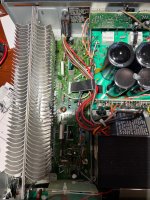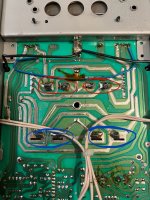Hi
I recently acquired a NAD 2700 in mint condition on the inside - and have been using it for a few days now - it plays fine and exits protection mode on power on in about 3-4 seconds - what I did discover is that it seems to stay in protection mode when I flip the back ohms setting switch to 8-16 ohms - I am doing this with the speakers disconnected btw - not sure if that makes a difference - anyway I didn’t play around with it too much in the 8-16 ohms- and flipped it back to 4-8 ohm setting as I was a bit weary of it getting stuck permanently in protection mode 🙂 - just wondering why it would be good in one setting vs staying in protection in the other - any quick tests I can check ( voltages etc ) to figure it out if I’m willing to try flipping the switch again? Main caps are original - amp sounds nice once warmed up in the 4 ohm settings - bias measures about 15 mv on one channel and 16 mv on the other - one other thing - this unit looks like brand new on the inside - like it’s been sitting in a closet for last 30 years before being taken out - it’s unreal !
I recently acquired a NAD 2700 in mint condition on the inside - and have been using it for a few days now - it plays fine and exits protection mode on power on in about 3-4 seconds - what I did discover is that it seems to stay in protection mode when I flip the back ohms setting switch to 8-16 ohms - I am doing this with the speakers disconnected btw - not sure if that makes a difference - anyway I didn’t play around with it too much in the 8-16 ohms- and flipped it back to 4-8 ohm setting as I was a bit weary of it getting stuck permanently in protection mode 🙂 - just wondering why it would be good in one setting vs staying in protection in the other - any quick tests I can check ( voltages etc ) to figure it out if I’m willing to try flipping the switch again? Main caps are original - amp sounds nice once warmed up in the 4 ohm settings - bias measures about 15 mv on one channel and 16 mv on the other - one other thing - this unit looks like brand new on the inside - like it’s been sitting in a closet for last 30 years before being taken out - it’s unreal !
Those amplifiers usually run a higher power supply voltage in high impedance mode. Make sure the rails switch to the higher voltage properly. If one side is missing completely or stays stuck at the wrong voltage there will be a huge DC offset. That should trigger the protection circuit.
The plastic on the cap was in fact bulging - I trimmed it back to expose the aluminum casing and that is just fine - don’t know why the cap plastic cover was puffy like that. I guess I can check the caps ( how ? ) - also I’m currently slowly reforming the caps just in case using a variac and have the amp hooked up - slowly raising voltage ( 5 volts every 2 hours or so )
Good point ! How do I check / test for that ? I ordered a service manual on eBay - should be here next week ( couldn’t find any downloads )Those amplifiers usually run a higher power supply voltage in high impedance mode. Make sure the rails switch to the higher voltage properly. If one side is missing completely or stays stuck at the wrong voltage there will be a huge DC offset. That should trigger the protection circuit.
Oddly though when I use a variac to bring up the AC voltage slowly at 35VAC, the left side red cap reads 18V and right side reads 27V ( both blue read 32V ). I haven’t taken it above 35 on the variac yet - would be good to know at what point they equalize .. raised variac to 45V AC and both sides at red terminals read 24V DC now, blue terminals read 39V
Last edited:
Is the 100V cap the one running the 98.5V terminal? Awfully close to rated voltage. Any power line variation could easily cross the max volt rating of the cap.
Boyd - you’re right - the original ones are actually rated at 120V. Hard to find replacements for those if any.
That would explain your protection issue, dig further in this area, eg, rectifier, check waveform with scope maybe getting halfwave rectified?Oddly though when I use a variac to bring up the AC voltage slowly at 35VAC, the left side red cap reads 18V and right side reads 27V
Increase variac a little does difference normalize a little.
The 100V caps(RED) are for the unregulated rails, connect to collectors of output transistors. The 120V caps(BLUE) are for the PE switchable rail
Increasing the variac to 45 V or higher brings both pairs to same voltages for the pair - I checked a good amp and that one does the same actually ( voltage diff on lower voltages up to 35 V and then equalizes past that ) - unless that amp has an issue as well but just not going into protection yet
- Home
- Amplifiers
- Solid State
- Like New old stock NAD 2700 - works in 4-8ohm setting - stays in protection mode at 8-16 ohm setting

